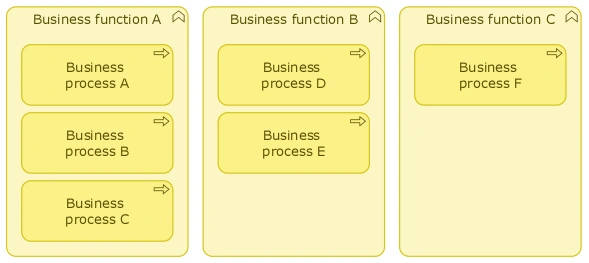A Business Process Map plays a critical role in analyzing, optimizing, and aligning an organization’s operations with its strategic goals. By understanding and modeling business processes, the Enterprise Architect can design effective business solutions, streamline operations, and ensure that technology and business strategies are tightly integrated for overall business success.
A business process represents a set of related activities or tasks performed by an organization to achieve a specific business goal or produce a specific output. Business processes are fundamental to the functioning of an organization because they define how work is performed and how different parts of the organization work together to deliver products or services.
Definition
A business process represents a sequence of business behaviors that achieves a specific result such as a defined set of products or business services1.
A Business Process Map is essentially an overview of all the processes used by an organization. These processes are (detailed) descriptions of the steps an employee takes or a system performs that lead to an end product or service.
An average organization may know and use up to hundreds of processes. Mapping them all can be a daunting task. Creating a coherent Business Process Map is therefore a difficult task for an Enterprise Architect. It requires a lot of research and countless conversations with people in an organization to correctly map all the processes.
What can help in creating a first draft of the Business Process Map is to inventory not the processes, but the business functions. Business functions are a collection or cluster of business processes.
Definition
A business function represents a collection of business behavior based on a chosen set of criteria such as required business resources and/or competencies, and is managed or performed as a whole2.
Applying the method
To document business processes, start by gathering information that is readily available, such as the organization’s intranet pages. Most organizations have an intranet, and it is often filled with valuable information about existing departments and their activities. The activities of departments are often described in detail, and there is more than enough information about what a department claims to do or what it can be used for.
Therefore, this information should be collected directly and translated into business functions. For example, if a department states that it performs analysis on data, this immediately leads to the business function Analyze Data. If it is stated somewhere that a department is involved in publishing documents on the corporate website, then the business function Publish Information can be extracted. A department such as Legal Affairs is often concerned with providing legal support, and Human Resources as a department is undoubtedly concerned with recruiting, onboarding, and maintaining personnel records.
Once there is an understanding of the business functions used, the conversation can begin with the relevant departments to find out what activities are performed within the context of the business functions found. This leads to the capture of business processes.
Gathering information
Within each department, ask the following questions to identify the processes used:
- What actions are performed during work?
- Are these actions in an application or are they process actions?
- Is someone in the department responsible for these actions?
- The business function [name] is related to the department. How is it performed?
Creating the map
In order to create a Business Process Map, follow the steps below.
- Record all the described processes and actions.
- Compare the described operations and remove any duplication.
- If possible, add the process owner directly.
- Add the related business function to the map.

A Business Process Map can also be represented graphically using a Business Process Diagram. Both the map and the diagram provide insight into which processes belong to which business functions, and thus form the basis for the next deliverable to be created.

More information
For additional information about creating a Business Process Map or Diagram, please refer to Chapter 8, Section 8.2.1.2, of my book Getting Started with Enterprise Architecture.
Back to
- The Open Group, ArchiMate® 3.2 Specification. ’s-Hertogenbosch: Van Haren Publishing, 2023. ↩︎
- The Open Group, ArchiMate® 3.2 Specification. ’s-Hertogenbosch: Van Haren Publishing, 2023. ↩︎
